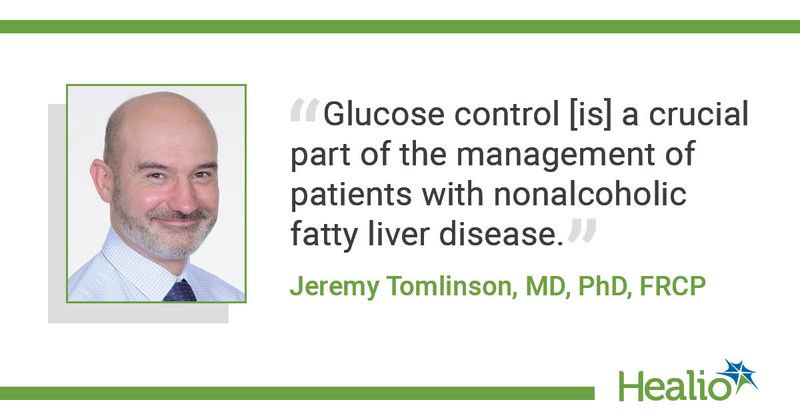Meeting target HbA1c may improve NAFLD for adults with type 2 diabetes
Adults with type 2 diabetes may be able to reduce their liver fat and improve their liver fibrosis stage with reductions in HbA1c, according to a study published in Nutrition, Metabolism & Cardiovascular Diseases.
In an analysis of data from adults with type 2 diabetes using an SGLT2 inhibitor, GLP-1 receptor agonist or DPP-IV inhibitor to improve their glycemic control, reducing HbA1c was correlated with improvements in fatty liver index and fibrosis-4 score (FIB-4), regardless of which glucose-lowering agent was used or BMI at baseline.

“We must pay attention to glucose control as a crucial part of the management of patients with nonalcoholic fatty liver disease (NAFLD),” Jeremy Tomlinson, MD, PhD, FRCP, professor of metabolic endocrinology at the Oxford Centre for Diabetes, Endocrinology and Metabolism at the University of Oxford, U.K., told Healio. “This goes hand-in-hand with all the other metabolic factors that we need to consider, such as weight loss, optimizing blood pressure, lipid-lowering treatments and smoking cessation. It also emphasizes the importance of a multidisciplinary approach to the management of patients with NALFD with diabetologists and metabolic physicians working alongside hepatologists.”
Tomlinson and colleagues conducted a retrospective study of clinical records from 637 adults with type 2 diabetes attending a clinic in Italy who were prescribed a GLP-1 receptor agonist, SGLT2 inhibitor or DPP-IV inhibitor from 2014 to 2017 (60% men; mean age, 61.6 years). Liver ultrasound was performed routinely for all participants. Fatty liver index and FIB-4 were used as markers for liver health. Adults who had a 1% or greater HbA1c reduction during a 12-month period were deemed good glycemic responders, those with an HbA1c reduction of 0.1% to 0.9% were moderate glycemic responders and adults with no change or an HbA1c increase were defined as glycemic nonresponders.
Of the cohort, 44% were good glycemic responders, 36% were moderate glycemic responders and 20% were nonresponders to therapy. From baseline to 1 year, adults who had a good glycemic response had a mean HbA1c reduction from 8.9% to 6.86%, moderate responders had an HbA1c reduction from 7.89% to 7.39% and nonresponders had an HbA1c increase from 7.59% to 8.23%. BMI and waist circumference both decreased in all groups. Adults who had an HbA1c decrease had a reduction in total cholesterol at 12 months, and the good glycemic responder group also had a reduction in alanine transaminase.
Prior to drug initiation, fatty liver index was correlated with HbA1c (R = 0.736; P = .001). After adjusting for change in BMI, age, drug class, baseline HbA1c and baseline fatty liver index, researchers observed a significant correlation between change in HbA1c and change in fatty liver index class at 1 year (r = 0.706; P < .001). Good glycemic responders had the largest change in fatty liver index at 1 year, with a smaller reduction observed in moderate responders and no change in nonresponders.
No correlation was observed between HbA1c and FIB-4 at baseline. However, at 1 year, HbA1c and FIB- 4 were positively correlated (R = 0.666; P = .001). Adults who were good glycemic responders to therapy had the greatest reduction in FIB- 4 from baseline to 1 year.
Tomlinson said randomized prospective studies must be conducted to confirm the study’s findings.
“In addition, we need to further explore the role that using insulin therapy might play, as there is some evidence that optimizing glucose control with insulin, despite the weight gain that we see with insulin therapy, can decrease liver fat content,” Tomlinson said. “We also need studies to work out exactly how improving glucose control translates to a decrease in liver fat.”
For more information:
Jeremy Tomlinson, MD, PhD, FRCP, can be reached at jeremy.tomlinson@ocdem.ox.ac.uk.

